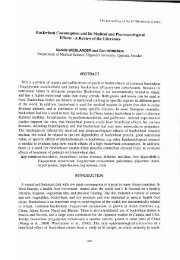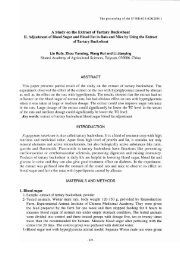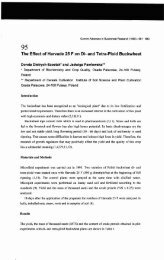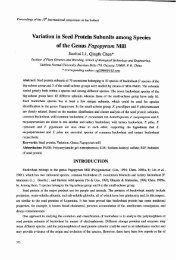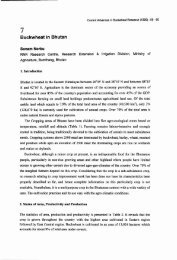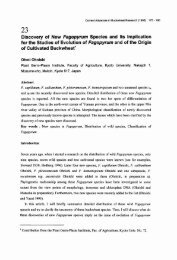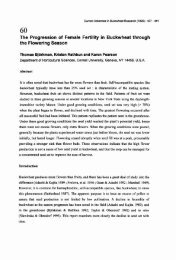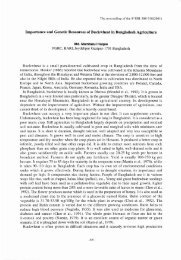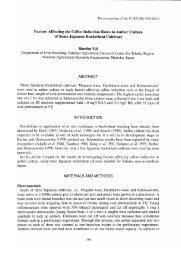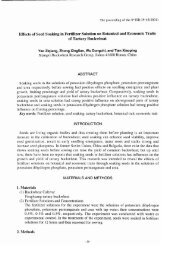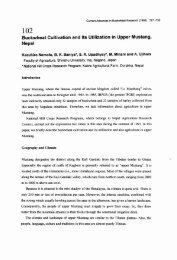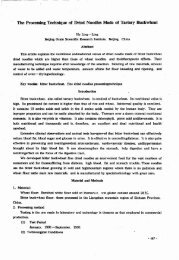Fagopyrum esculentum and F. tataricum
Fagopyrum esculentum and F. tataricum
Fagopyrum esculentum and F. tataricum
You also want an ePaper? Increase the reach of your titles
YUMPU automatically turns print PDFs into web optimized ePapers that Google loves.
Current Advances in Buckwheat Research (1995) : 357 - 364<br />
48<br />
Variation of Seed Proteins in the World Cultivars of<br />
<strong>Fagopyrum</strong> <strong>esculentum</strong> <strong>and</strong> F. <strong>tataricum</strong><br />
Yutaka Hirata*, Koichiro Ushijima* <strong>and</strong> Ryo Ohsawa**<br />
* Faculty of Agriculture, Tokyo University of Agriculture & Technology, Fuchu, Tokyo,<br />
Japan<br />
** Hokuriku Agricultural Experiment Station, Ojiya, Niigata, Japan<br />
Introduction<br />
Important buckwheat includes two species <strong>and</strong> these two species diverse into several thous<strong>and</strong>s<br />
of cultivars in the world, such as South East Asia, Europe, Russia <strong>and</strong> North America. Those<br />
cultivars include wide variations in yield, protein <strong>and</strong> rutin contents, photoresponse <strong>and</strong> so on.<br />
Common buckwheat is strongly heterozygous <strong>and</strong> the criterion "cultivar" is not accompalished<br />
because of strong allogamous plant which is regulated by heterostyly self-incompatibility.<br />
Recently allergenic alubumins were widely known <strong>and</strong> partial characterizations were analysed.<br />
However, to improve the qualities <strong>and</strong> quantities ofbuckwheat we must make clear the spectra<br />
ofvariations in important agricultural characteristics such as proteins, rutin content with ordinal<br />
characteristics. For that purpose, it is necessary to know world-wide variations. Firstly we tried<br />
to survey the variations in seed storage proteins. In parallel geographycal variations <strong>and</strong><br />
declines were also studied.<br />
Materials <strong>and</strong> Methods<br />
Material cultivars used were 104 common buckwheat cultivars <strong>and</strong> 7 tartary buckwheat<br />
cultivars from the collections by Hokuriku Agricultural Experiment Station (Ojiya, Niigata,<br />
Japan). Typical seeds are shown in Fig. 1.<br />
We analysed buckwheat globulin subunits by SOS-PAGE (sodium dodesyl sulfate<br />
polyacrylamide gel electrophoresis) <strong>and</strong> those acidic subunits by alkaline-urea PAGE.<br />
Ten seeds of each buckwheat cultivar were crashed <strong>and</strong> ground. Globulins were extracted<br />
from 5 mg seed powder in 80 III 0.1 M phosphate buffer (pH 7.4) containing 0.4 M NaCI, 0.1 M<br />
2-mercaptoethanol <strong>and</strong> 10% SOS. 20 III of the extracted supernatant after centrifuge (15,000<br />
rpm for 20min.) was served for (mini) slab gel (10%) electrophoresis (10 rnA CC for 4hrs in<br />
electrode buffer; 3 g Tris-14.4 g Glycine (pH 8.3) containing 10% SDS per 100 ml). In case of<br />
alkaline-urea SOS PAGE, globulin proteins were extracted in 0.05 M Tris-HCI (pH 6.8)
358<br />
containing 2.5% SDS, 0.1 % 2-mercaptoethanol <strong>and</strong> 8 M urea. For separation by gel<br />
electrophoresis 10% gel includes 6 M urea was used. Low bis acrylamige gel system (Acryl<br />
amide: Bis acryl amide = 30 : 0.001) was applied to seperate low molecular proteins if<br />
necessary.<br />
In this paper we focusted on common buckwheat proteins because of too small number of<br />
F. tartaricum cultivars.<br />
Results<br />
Fundamental separation patterns oftotal globulin subunits <strong>and</strong> acidic subunits were respetively<br />
shown in Fig. I <strong>and</strong> Fig. 2. Qualitative variations were clear between F. <strong>esculentum</strong> <strong>and</strong><br />
<strong>tataricum</strong>. However, qualitative variations were rarely found in common buckwheat.<br />
Quantitative variations were very frequent in common buckwheat. Ralative production ratios<br />
between two near-subunits were adopted for detection ofvariations.<br />
Relative production of globulin subunits G1 to G8 were surveyd (Fig. 2). However, clear<br />
geographic clines were not found for each relative production ratio between two near-b<strong>and</strong>s so<br />
far. However, four cultivars or strains, Bednja (Yugoslavia), 92-41 strain (Niigata),<br />
Toyamazairai (lwate) <strong>and</strong> Kankei No.3 (Kanto) which have G7
Fig. 2a. Variation of globulin subunits. Left four are common buckwheat cultivars, right four<br />
tartary buckwheat culrtivars. Arrowheads indicate species - specific subunits of variated<br />
subunits.<br />
Fig. 2b. Schematic explanation ofelectrophoretic separation pattern ofglobulin subunits. Upper<br />
is tartary buckwheat, lower common buckwheat.<br />
FT<br />
FE<br />
359
Japan, all subunit compositions were in same declines, AI>A2, A2
364<br />
From the results with proteins, three acidic subunit separation patterns were classified into<br />
Japanese <strong>and</strong> North American type, European type <strong>and</strong> Chinese type. The first group is<br />
reasonable to include the same group, because Japanese type is cultivated in Canada <strong>and</strong> USA<br />
for export to Japan. From the view point of that, A3, A4 <strong>and</strong> A5 would be adequate indicators<br />
to classify between European <strong>and</strong> Japanese types.<br />
Discussion<br />
In this experiment qualitative variations were not clearly found. This is the reason that genes<br />
for protein subunits are heterozygous in one cultivar or strain because of strong allogamy <strong>and</strong><br />
self-weakness in common buckwheat. So, the defferent productivity between two near-subunits<br />
may be source of variation in the subnints in case of common buckwheat. Further survey in<br />
each plant <strong>and</strong> the progenies by using clear markers is necessary. Of course, tartary buckwheat<br />
is relative easy to survey variations due to self-pollinated plant.<br />
By using total globulin subunits <strong>and</strong> acidic subunits there were several distictive cultivars<br />
such as AlA3 <strong>and</strong> G7




